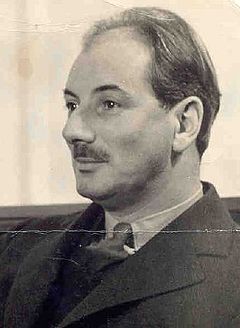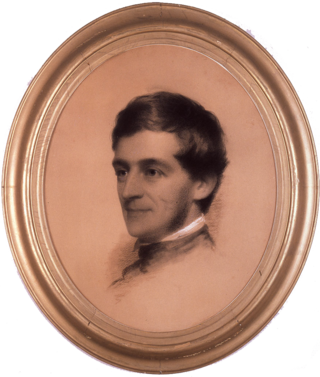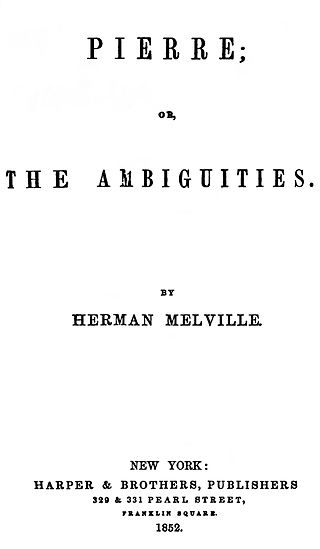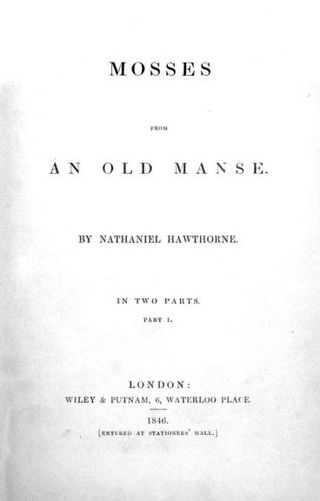
Eric Arthur Blair, better known by his pen name George Orwell, was an English novelist, essayist, journalist, and critic. His work is characterised by lucid prose, social criticism, opposition to totalitarianism, and support of democratic socialism.

Herman Melville was an American novelist, short story writer, and poet of the American Renaissance period. Among his best-known works are Moby-Dick (1851); Typee (1846), a romanticized account of his experiences in Polynesia; and Billy Budd, Sailor, a posthumously published novella. At the time of his death, Melville was no longer well known to the public, but the 1919 centennial of his birth was the starting point of a Melville revival. Moby-Dick eventually would be considered one of the great American novels.

Moby-Dick; or, The Whale is an 1851 novel by American writer Herman Melville. The book is the sailor Ishmael's narrative of the maniacal quest of Ahab, captain of the whaling ship Pequod, for vengeance against Moby Dick, the giant white sperm whale that bit off his leg on the ship's previous voyage. A contribution to the literature of the American Renaissance, Moby-Dick was published to mixed reviews, was a commercial failure, and was out of print at the time of the author's death in 1891. Its reputation as a Great American Novel was established only in the 20th century, after the 1919 centennial of its author's birth. William Faulkner said he wished he had written the book himself, and D. H. Lawrence called it "one of the strangest and most wonderful books in the world" and "the greatest book of the sea ever written". Its opening sentence, "Call me Ishmael", is among world literature's most famous.

Down and Out in Paris and London is the first full-length work by the English author George Orwell, published in 1933. It is a memoir in two parts on the theme of poverty in the two cities. Its target audience was the middle- and upper-class members of society—those who were more likely to be well educated—and it exposes the poverty existing in two prosperous cities: Paris and London. The first part is an account of living in near-extreme poverty and destitution in Paris and the experience of casual labour in restaurant kitchens. The second part is a travelogue of life on the road in and around London from the tramp's perspective, with descriptions of the types of hostel accommodation available and some of the characters to be found living on the margins.

Ishmael is a character in Herman Melville's Moby-Dick (1851), which opens with the line, "Call me Ishmael." He is the first person narrator in much of the book. Because Ishmael plays a minor role in the plot, early critics of Moby-Dick assumed that Captain Ahab was the protagonist. Many either confused Ishmael with Melville or overlooked the role he played. Later critics distinguished Ishmael from Melville, and some saw his mystic and speculative consciousness as the novel's central force rather than Captain Ahab's monomaniacal force of will.

Lewis Mumford was an American historian, sociologist, philosopher of technology, and literary critic. Particularly noted for his study of cities and urban architecture, he had a broad career as a writer. He made signal contributions to social philosophy, American literary and cultural history, and the history of technology.

Billy Budd, Sailor , also known as Billy Budd, Foretopman, is a novella by American writer Herman Melville, left unfinished at his death in 1891. Acclaimed by critics as a masterpiece when a hastily transcribed version was finally published in 1924, it quickly took its place as a classic second only to Moby-Dick among Melville's works. Billy Budd is a "handsome sailor" who strikes and inadvertently kills his false accuser, Master-at-arms John Claggart. The ship's Captain, Edward Vere, recognizes Billy's lack of intent, but claims that the law of mutiny requires him to sentence Billy to be hanged.
"Bartleby, the Scrivener: A Story of Wall Street" is a short story by the American writer Herman Melville, first serialized anonymously in two parts in the November and December 1853 issues of Putnam's Magazine and reprinted with minor textual alterations in his The Piazza Tales in 1856. In the story, a Wall Street lawyer hires a new clerk who, after an initial bout of hard work, refuses to make copies or do any other task required of him, refusing with the words "I would prefer not to."

"Self-Reliance" is an 1841 essay written by American transcendentalist philosopher Ralph Waldo Emerson. It contains the most thorough statement of one of his recurrent themes: the need for each person to avoid conformity and false consistency, and follow his or her own instincts and ideas. It is the source of one of his most famous quotations:
Mary Folger was the maternal grandmother of Benjamin Franklin, a Founding Father of the United States. In Herman Melville's 1851 novel Moby-Dick, she was cited as an ancestor of the Folger whalers.

Redburn: His First Voyage is the fourth book by the American writer Herman Melville, first published in London in 1849. The book is semi-autobiographical and recounts the adventures of a refined youth among coarse and brutal sailors and the seedier areas of Liverpool. Melville wrote Redburn in less than ten weeks. While one scholar describes it as "arguably his funniest work", scholar F. O. Matthiessen calls it "the most moving of its author's books before Moby-Dick".

Pierre; or, The Ambiguities is the seventh book by American writer Herman Melville, first published in New York in 1852. The novel, which uses many conventions of Gothic fiction, develops the psychological, sexual, and family tensions between Pierre Glendinning; his widowed mother; Glendinning Stanley, his cousin; Lucy Tartan, his fiancée; and Isabel Banford, who is revealed to be his half-sister. According to scholar Henry A. Murray, in writing Pierre Melville "purposed to write his spiritual autobiography in the form of a novel" rather than to experiment and incidentally work some personal experience into the novel.
"Isle of the Cross" is a possible unpublished and lost work by Herman Melville, which would have been his eighth book, coming after the commercial and critical failures of Moby-Dick (1851) and Pierre: or, The Ambiguities (1852). Melville biographer Hershel Parker suggests that the work, perhaps a novel, perhaps a story, was what had been known as the "story of Agatha," completed around May 1853. He further suggests that finishing the work showed that Melville had not, as many biographers argued, been discouraged and turned away from fiction.
Michael Shelden is an American biographer and teacher, notable for his authorized biography of George Orwell, his history of Cyril Connolly's Horizon magazine, his controversial biography of Graham Greene, and his study of the last years of Mark Twain, Man in White. In March 2013 his Young Titan: The Making of Winston Churchill was published. In 2016 his biography of Herman Melville, Melville in Love, was published by Ecco/HarperCollins.

The bibliography of Herman Melville includes magazine articles, book reviews, other occasional writings, and 15 books. Of these, seven books were published between 1846 and 1853, seven more between 1853 and 1891, and one in 1924. Melville was 26 when his first book was published, and his last book was not released until 33 years after his death. At the time of his death he was on the verge of completing the manuscript for his first novel in three decades, Billy Budd, and had accumulated several large folders of unpublished verse.

"Hawthorne and His Mosses" (1850) is an essay and critical review by Herman Melville of the short story collection Mosses from an Old Manse written by Nathaniel Hawthorne in 1846. Published pseudonymously by "a Virginian spending July in Vermont", it appeared in The Literary World magazine in two issues: August 17 and August 24, 1850. It has been called the "most famous literary manifesto of the American nineteenth century."
Raymond Melbourne Weaver was a professor of English and comparative literature at Columbia University in 1916–1948, and a literary scholar best known for publishing Herman Melville: Mariner and Mystic, the first full biography of American author Herman Melville (1819–1891) in 1921 and editing Melville's works. Weaver's scholarly credentials, training, and persuasiveness were important in launching the "Melville Revival" of the 1920s that brought Melville from obscurity to wide recognition.
Harrison Mosher Hayford was a scholar of American literature, most prominently of Herman Melville, a book-collector, and a textual editor. He taught at Northwestern University from 1942 until his retirement in 1986. He was a leading figure in the post-World War II generation of Melville scholars who mounted the Melville Revival. He was General Editor of the Northwestern-Newberry The Writings of Herman Melville published by Northwestern University Press, which established reliable texts for all of Melville's works by using techniques of textual criticism.
Walter E. Bezanson was a scholar and critic of American literature best known for his studies of Herman Melville and contributions to the Melville revival that restored the writer to prominence in the 1940s and 1950s. Bezanson's research and editorial work rescued from neglect Mevlille's unappreciated epic poem, Clarel, and he published essays on Moby-Dick that were widely cited and reprinted.
Howard Paton Vincent (1904–1985) was an American scholar of American literature who taught at Kent State University from 1961 until his retirement in 1975. He is best known for his work on Herman Melville and the Melville revival, he was also an authority on Honore Daumier,












